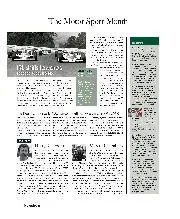
In brief, October 2009
A Lamborghini Murciélago has become the third car to be developed for the new-for-2010 FIA GT1 World Championship. The German Reiter Engineering team unveiled its Murciélago R-SV at the Spa…
Porsche’s mighty 917 had been legislated out of the World Championship for Makes at the end of 1971, but little more than a year later the German marque was once again notching up big victories in prestigious sports car enduros. Not with a prototype, but with a GT car — the Porsche 911 Carrera RSR.
The new Porsche, initially in 2.8-litre form, claimed a victory on its race debut in the 1973 Daytona 24 Hours with the Brumos team. The car driven by Peter Gregg and Hurley Haywood beat a modest and fragile field of prototypes in February ’73, although by way of a paperwork quirk it was running as one itself. The new RSR, which introduced the world to Porsche’s duck-tail rear spoiler, had yet to be homologated, so had to run as a prototype.
Seven weeks later, Gregg and Haywood made it two big wins from two starts at the Sebring 12 Hours, this time sharing with owner-driver Dave Helmick. They triumphed against a field of GT cars in what was no longer a round of the WCM – exactly what the RSR had been conceived to do.
Porsche had been building hot versions of the 911 for race tracks and rally stages for years, but the stars aligned in the creation of a machine that is right up there in the pantheon of the marque’s great racing cars.
Customers were clamouring for a more competitive car for international GT racing and rallying, at a time when the firm’s resources had been freed up after a new 3-litre capacity limit did for the 917’s
world championship career. The company hierarchy also happened to be looking for a halo car to reinvigorate the now nine-year-old 911 model line.
“The RS and RSR did the job for which they were intended”
The capacity of the flat-six boxer engine had already been creeping up as the customer racing department strove to keep the car on the money in the GT ranks. Now, Porsche took the engine out to 2.7 litres for the Group 3 Carrera RS, the homologated base car, and 2.8 litres for the full-house Group 4 racer. A 3 litre followed for 1974.
The RS and RSR did the job for which they were intended. Kremer Racing won the European GT Championship with Clemens Schickentanz in 1973, and John Fitzpatrick followed up on that success the following season, having started out with Georg Loos’ Gelo Racing before switching to Kremer.
There were class victories at the Le Mans 24 Hours, too. Kremer won the GTS class in ’73 and the victories kept coming for the car right up until 1978.
The RSR served another purpose as well, by providing Porsche’s customers with a winning GT option. It was a lead-in to the forthcoming Group 5 ‘special production’ class that would eventually be delayed until 1976. The rules allowed for a manufacturer to develop a Group 5 silhouette racer out of a Group 4 car. The RSR was that machine.
Development of what eventually became the Porsche 935 started earlier than expected. When the factory squad was picked up by the scrutineers at Monza ’73 for a modification to the rear suspension, it made an overnight swap to the prototype class.
A bigger rear wing appeared for the race, and Porsche opted to stay in the higher category to allow it to develop the RSR. Bigger fenders and larger wheels followed during a season that included another giant-killing win in the Targa Florio. A turbocharged engine would then come on stream in ’74.
The RSR was a success – and also set Porsche on course for even bigger things.
Porsche 911 Carrera RSR
• Price new N/A
• Price now £1.75-2.5m
• Engine 2.8-litre flat-six
• Power 280bhp
• Le Mans class wins 8
• Verdict The definitive Porsche GT racer of its time. It set a benchmark for customer cars that the company still follows to this day
Air-cooled 911s have always been popular
It’s no secret that the values of air-cooled Porsches have accelerated over the past 10 years, and the RS and RSR models are no exception.
American auctions dominate 1974 RSR sales and prices steadily increased each time one came to market. To underline the point, prices climbed from £380,000 at the Bonhams Quail Lodge auction in 2010 through to a peak of £1.6m at Amelia Island in 2016.
While the 1973 RS hasn’t experienced such large gains, values do seem to be somewhat more stable. This might in part be due to the international nature of the market for the RS, with recent sales in Japan, France, Germany, America and the UK. In 1973 a Touring sold at Bonhams in London for £319,000, while at a 2016 RM Sotheby’s auction one fetched £460,000. Two sales in 2019 suggest continued strong support, with a £450,000 sale in Paris in February and another for £420,000 at Como in May.
Singer and Magnus Walker have probably done more to raise the profile of air-cooled Porsches among younger generations than the factory could have imagined, so demand should remain strong.
The RSR, a race-spec development of the RS, is a lot more pricey, especially for one with proven heritage.
Robert Johnson, Classic and Sports Finance
